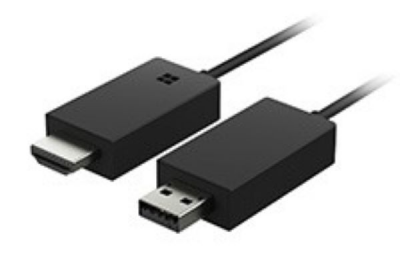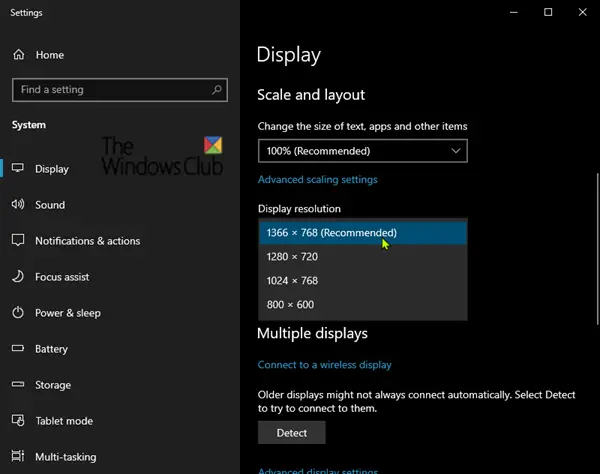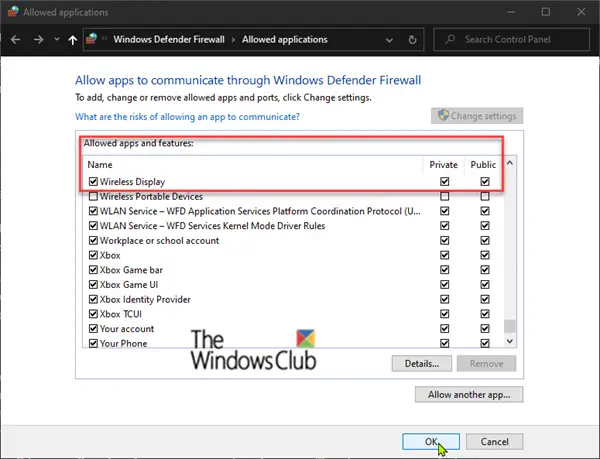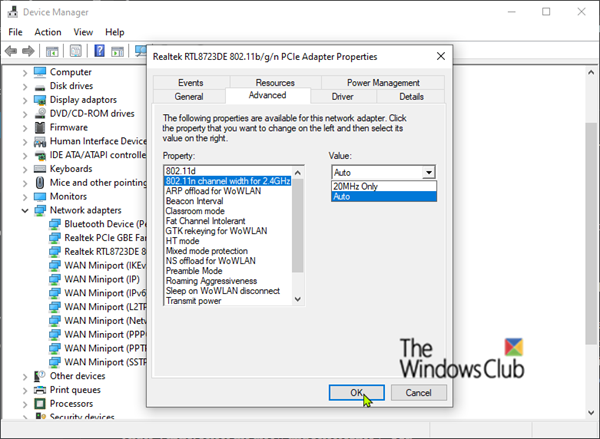If you run into a snag with a Microsoft Wireless Display Adapter on Windows 11/10, then in this post, we provide some troubleshooting steps to help you resolve the issues. You may face issues where you find that your Microsoft Wireless Display Adapter is not connecting, working, showing up or does not have sound.
Microsoft Wireless Display Adapter not working

Before you begin, plug the adapter into an HDMI port on your HDTV, monitor, or projector and into a USB charging port. The adapter gets its power through the USB charging port.
For best performance, keep your device within 23 feet of the HDTV, monitor, or projector. To connect the adapter to your HDTV, monitor, or projector, refer to the product guide for the type of adapter you have, as pictured below. The adapter can connect to only one HDTV, monitor, or projector at a time.
The Microsoft Wireless Display Adapter (with Microsoft Four Square Logo) is supported on select Android devices. If you need more help projecting from your Android or another device, check your device manufacturer’s website.
The Microsoft Wireless Display Adapter app must be in the foreground on your device while installing firmware updates. Suspending the app will also suspend the update or may cause it to fail.
Open the Wireless Display Adapter app and connect your adapter. Select Firmware on the left side of the navigation pane in the app and you will get the details there to update the firmware.
The issue(s) you might encounter with the adapter can range from but not limited to, as follows:
- Issues with the Microsoft Wireless Display Adapter app.
- Display is not to scale, or some parts of the display are missing.
- Issues with video or audio playback.
- Unable to connect your device to the adapter.
Now, let’s delve into the detailed troubleshooting steps.
1] Issues with the Microsoft Wireless Display Adapter app
Here are some things to try.
A) The app shows “You’re not connected”
If the message “You’re not connected” appears in the app:
- Make sure both the HDMI end and the USB end of the adapter are connected to your HDTV, monitor, or projector.
- In the app, select Refresh.
B) App always shows “Waiting for connection”
If the app always shows “Waiting for connection,” first make sure your device is connected to the adapter, then disconnect the adapter and reconnect it.
Here’s how:
- Swipe in from the right edge of the screen or select Action Center in the taskbar.
- Select Connect. The adapter will appear at the top of the menu. (If the adapter doesn’t appear at the top, your device isn’t connected to the adapter.)
- Select the name of the Microsoft Wireless Display Adapter and select Disconnect.
- Swipe in from the right edge of the screen or select Action Center.
- Select Connect, and from the list of displays, select the name of the Microsoft Wireless Display Adapter to reconnect your device to the adapter.
The adapter won’t work if you’re using a proxy server to access the internet.
2] Display is not to scale, or some parts of the display are missing
If part of the screen on your device doesn’t appear on your second screen, the display might not be to scale. Try these solutions:
A) Adjust the resolution on your device
If you’ve set the resolution on your device to a lower resolution than its default setting, you can increase the resolution so it will fit correctly on your second screen.
Here’s how:
- In the search box on the taskbar, type screen resolution, then select Change the screen resolution from the results.
- Under Resolution, click the chevron for the drop-down menu and then select the resolution that is Recommended. The highest resolution is the recommended resolution on the device.

B) Use the Microsoft Wireless Display Adapter app to adjust display settings
You can use the adapter app to change how the screen on your device scales to the screen on your HDTV, monitor, or projector.
Here’s how:
- Open the Microsoft Wireless Display Adapter app.
- Under Adjust display, drag the slider to the right until you can see everything that’s on your device on the HDTV, monitor, or projector.
3] Issues with video or audio playback
Here are some solutions to try:
A) Nothing displays on the second screen
If you can connect your device to the adapter but nothing displays on your second screen, try performing the steps in the solution 4] below. If that doesn’t solve the issue, try these solutions:
- Make sure your device is set to duplicate or extend the screen.
- Unplug the USB end of the adapter to turn it off, and plug it back in to turn it on again.
- Make sure your HDTV, monitor, or projector is set to the HDMI channel. To check or change the video input settings on your display, refer to the product guide that came with your device or go to the manufacturer’s website.
- Make sure your HDTV, monitor, or projector supports HDCP. If you aren’t sure if your display supports HDCP, refer to the product guide that came with your device or go to the manufacturer’s website.
B) Video is pixelated or audio stutters
If you notice pixelation in the video or if the audio stutters, try the following:
- Move your device closer to the adapter. For best performance, your device should be within 23 feet of your HDTV, monitor, or projector.
- Move the adapter away from microwave ovens, cordless phones, or baby monitors. Common household electronics such as these can cause radio frequency interference that may disrupt the connection between your device and the adapter.
- If you don’t have enough room to plug the adapter into the HDMI port on your second screen, use the HDMI extension cable that was included in the box your adapter came in. If you’ve plugged the adapter into the HDMI port at an angle, this can cause issues with the video quality.
C) App-based video cannot play while connected to the Wireless Display Adapter
If you’re having issues playing video and content from an application service such as Netflix, YouTube, or Amazon Instant Video, try the below steps:
- Make sure the adapter is up to date. Refer to the Microsoft guide provided above.
- Close and relaunch, or refresh the app.
- Disconnect from the Wireless Display Adapter.
- Restart the device.
- Reconnect to the adapter and try playing the video again.
D) Video plays on your device but is frozen on your second screen
If video plays correctly on your device but is frozen on your second screen, disconnect the adapter from your device and the display, and reconnect it.
Here’s how:
- Swipe in from the right edge of the screen or select the action center in the taskbar.
- Select Connect, select the name of the Microsoft Wireless Display Adapter, and select Disconnect.
- Unplug both ends of the adapter from your HDTV, monitor, or projector and plug them in again.
- Swipe in from the right edge of the screen or select the action center.
- Select Connect, and in the list of displays, select the name of the Microsoft Wireless Display Adapter to reconnect your device to the adapter.
E) Poor video quality
If the quality of the streaming video is poor, here are some ways to help improve it:
- Make sure you’re not using an HDMI to VGA converter. Converting from HDMI to VGA reduces the signal strength of the video output and can distort the images.
- Reduce radio frequency interference by moving the adapter away from microwave ovens, cordless phones, and other common household electronics.
- Move your device closer to the adapter. The adapter works best when it’s within 23 feet of your device.
- Download higher-quality video. The source itself might be of poor quality, which will affect the quality of the streaming video.
F) Video plays on the connected display, but audio comes from your device
- In the search box on the taskbar, type sound, and then select Sound from the results.
- Select Playback > Speakers/Intel WiDi > Set Default > OK.
G) Can’t change the resolution on your device
If the resolution on your HDTV, monitor, or projector is less than 1080p, your device will default to that resolution while it’s connected to the display.
You need an HDTV, monitor, or projector that supports up to 1080p resolution to stream content from your device in that resolution. After you disconnect your device from the adapter, your device will revert to its default resolution.
4] Unable to connect your device to the adapter
If you’re having trouble connecting your device to the Microsoft Wireless Display Adapter, try these solutions in this particular order.
A) Install the latest updates
Installing the latest updates for your device and Windows can help fix many common connection issues. For Windows devices, refer to this TWC guide.
If installing updates doesn’t help, proceed with the next solution.
B) Check your HDMI and USB connections.
Make sure both the HDMI end and USB end of the adapter are connected correctly.
- Make sure the HDMI end of the adapter is connected to the HDMI port on your HDTV, monitor, or projector. Use the included HDMI extension cable if needed.
- Make sure the USB end of the adapter is plugged into a USB power source.
- If the HDTV, monitor, or projector you’re connecting to doesn’t have a USB charging port, you can use the USB charging port on a device power supply or any other USB charger.
- Use a USB extension cord if you need more length for your USB connector.
- Make sure the electrical outlet you’re using for USB power is working properly. Test it by plugging in something else.
Still having issues after checking your connections, proceed with the next solution.
C) Reset the adapter
Try resetting the adapter. This is also helpful if you’ve forgotten your password.
Here’s how:
- On the adapter next to the wired connection, press and hold the reset button for 10 seconds. The LED light on the adapter will blink.
- When the message “Ready to connect” appears on your second screen, swipe in from the right edge of your device screen or select Action Center in the taskbar.
- Select Connect, and in the list of displays, select the name of the Microsoft Wireless Display Adapter.
If th problem still unresolved, proceed with the next solution.
D) Remove the adapter and reconnect.
There might be a problem with the connection between your device and the adapter. To fix the issue, try disconnecting the adapter from your device and reconnecting it.
Here’s how:
- Select Start > Settings > Devices > Connected devices.
- Under Projectors, select the name of the Microsoft Wireless Display Adapter and select Remove device.
- Select Add a device to connect your device and the Microsoft Wireless Display Adapter.
If disconnecting and reconnecting the adapter doesn’t resolve the issue, proceed with the next solution.
E) Allow the adapter to communicate through Windows Firewall.
Windows Firewall might be preventing the adapter from connecting to your device. To allow the adapter to communicate through the firewall, do the following:
- In the search box in the taskbar, type allow firewall, and in the search results, select Allow an app through Windows Firewall.
- Under Name, find Wireless Display and make sure Private and Public are checked. Then, click OK.

Note: If you can’t select anything in the Allowed apps and features box, you aren’t logged in as an administrator. Select Change Settings, type your administrator password, and then select Yes. Your administrator password should be the same as the password you used to set up your device.
If your firewall is set to allow the adapter to communicate but you still can’t connect, proceed with the next solution.
F) Change the wireless frequency band on your device.
The Microsoft Wireless Display Adapter can communicate with devices on either the 2.4GHz or 5GHz wireless frequency bands, but you must have the 2.4GHz band enabled on your device when you’re pairing your device with the adapter.
If you still can’t connect your device to the adapter, the 2.4GHz band might be disabled.
Surface Pro, Surface Pro 2, and Surface 2 default to the 2.4GHz band and this can’t be changed.
Here’s how to enable the 2.4 GHz, or 5 GHz band:
- Right-click Start and select Device Manager.
- Click the chevron next to Network adapters, to collapse the section.
- Right-click your device’s network adapter. Select Properties > Advanced.
If you don’t see the Advanced tab, you’re not logged in as an administrator. Select Change Settings, enter your administrator password and select Yes. Your administrator password should be the same as the password you used to set up your device. Next, select Advanced.
- Under Property field, select Band.
- Under Value field, click the chevron for the drop-down menu and select Auto.
- Click OK.

If you still can’t connect, proceed with the next solution.
G) Reinstall the Intel HD Graphics driver.
- Select Start > Settings > Devices > Connected devices.
- Select Add a device to connect your device and the Microsoft Wireless Display Adapter.
If you still can’t connect your device to your Microsoft Wireless Display Adapter, proceed with the next solution.
H) Uninstall and Reinstall the device Wi-Fi driver.
Refer to the TWC guide above. After you must have uninstalled the Wi-Fi driver, repeat the same step as above, to connect your device and the Microsoft Wireless Display Adapter.
After you have exhausted all these solutions given and you still can’t connect your device to your Microsoft Wireless Display Adapter, contact Microsoft Support.
How do I fix Wireless Display installation failed in Windows 11?
To fix the wireless display installation failed error in Windows 11, you can go through the aforementioned solutions. Before that, you must identify the exact error so that the list of solutions gets shortened and you fix the issue quickly. However, in most cases, it is the cable and settings that you need to check.
How do I fix Miracast not supported on this device issue in Windows 11?
If your display supports wireless display facility, only then you can use Miracast. Otherwise, you will keep getting the Miracast is not supported on this device error while trying to connect a wireless display. No matter whether you use Windows 11 or Windows 10, the error message and solutions remain the same.
Hope this helps!
Leave a Reply